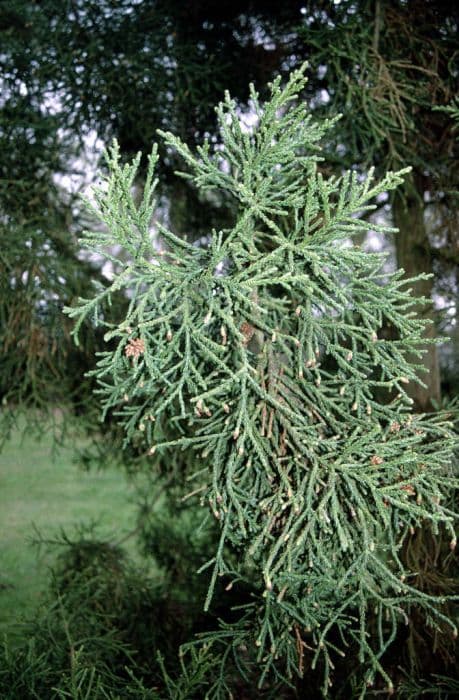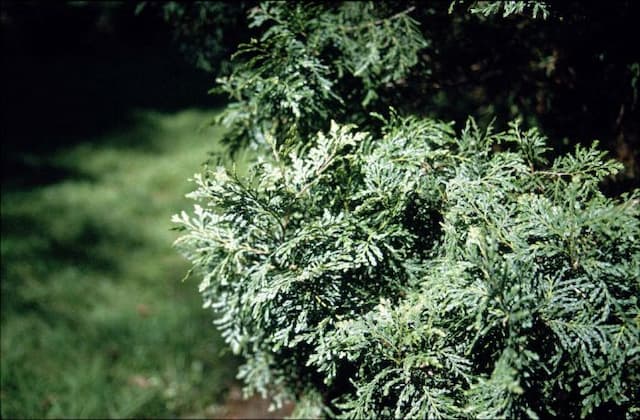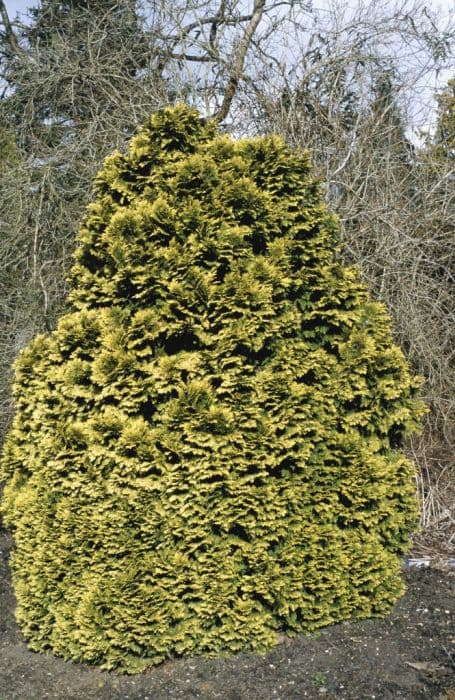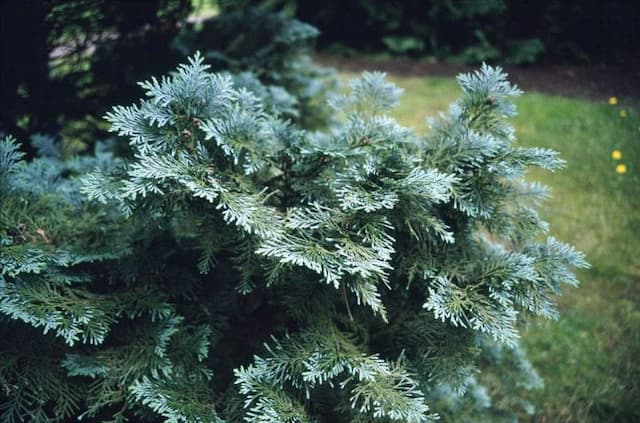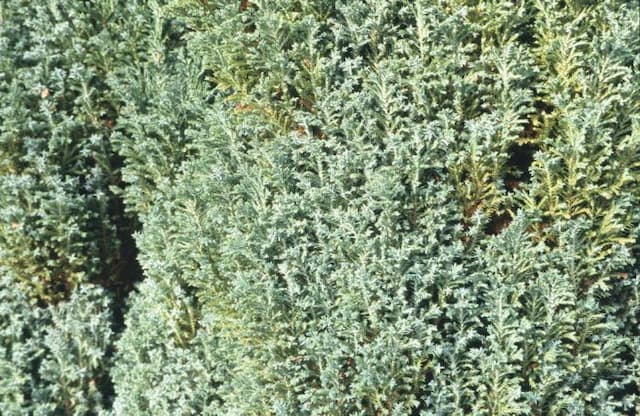Leyland cypress × Cuprocyparis leylandii

ABOUT
a large, fast-growing, dense conifer of columnar habit which can reach heights in excess of 30m if unchecked. Its dense foliage forms flattened, slightly drooping sprays of scale-like leaves
About this plant
 Names
NamesFamily
Cupressaceae
Synonyms
Leyland Cypress, Leylandii
Common names
Cupressus × leylandii, Cupressus macrocarpa × Cupresus nootkatensis, Callitropsis × leylandii, Hesperotropsis leylandii, × Hesperocyparis leylandii, Cupressocyparis leylandii.
 Characteristics
CharacteristicsLife cycle
Perennials
Foliage type
Evergreen
Color of leaves
Green
Height
60 feet [18 meters]
Spread
15 feet [4.5 meters]
Plant type
Tree
Hardiness zones
6
Native area
Britain
Benefits
 General Benefits
General Benefits- Fast Growth: Leyland cypress is known for its rapid growth rate, which makes it an ideal choice for quickly establishing privacy screens or hedges.
- Windbreak: Its dense foliage serves as an effective windbreak, helping to protect more delicate plants and reducing wind speed in gardens and landscapes.
- Noise Reduction: Leyland cypress can help to dampen noise pollution, creating a more peaceful environment.
- Visual Appeal: With its tall, columnar shape and evergreen foliage, Leyland cypress adds aesthetic value to the landscape throughout the year.
- Low Maintenance: Once established, Leyland cypress requires relatively little care, saving time and effort in garden maintenance.
- Wildlife Habitat: The thick foliage of Leyland cypress can provide nesting sites and shelter for birds and other wildlife.
 Medical Properties
Medical PropertiesThis plant is not used for medical purposes.
 Air-purifying Qualities
Air-purifying QualitiesThis plant is not specifically known for air purifying qualities.
 Other Uses
Other Uses- Leyland cypress wood chips are often used in the production of particleboard and fiberboard due to their favorable characteristics such as light weight and uniformity.
- The wood from Leyland cypress can be used in the creation of musical instruments, particularly woodwind instruments, for its resonant qualities and aesthetic wood grain.
- Landscape artists sometimes employ Leyland cypress in the creation of topiary gardens, taking advantage of the plant's dense foliage to sculpt living art.
- Leyland cypress can be used as a windbreak in coastal areas, helping to protect other plants and soil from harsh sea winds and salt spray.
- The plant is occasionally utilized in erosion control projects, as its root system helps stabilize soil on slopes and prevent landslides.
- Due to their fast growth and dense foliage, Leyland cypresses are used in outdoor privacy screens or natural fencing around properties.
- The tree's tall and straight traits make it a candidate for utility poles after proper treatment, although this is not a common practice.
- Some artisans use Leyland cypress wood to craft rustic furniture, where the wood's natural beauty can be showcased.
- In larger properties and parks, Leyland cypress is used to create mazes or labyrinth gardens for public enjoyment and interactive landscape experiences.
- Biomass from Leyland cypress can be used for bioenergy production, as part of renewable energy initiatives to reduce reliance on fossil fuels.
Interesting Facts
 Feng Shui
Feng ShuiLeyland Cypress is not used in Feng Shui practice.
 Zodiac Sign Compitability
Zodiac Sign CompitabilityLeyland Cypress is not used in astrology practice.
 Plant Symbolism
Plant Symbolism- Fast Growth: Leyland cypress is known for its rapid growth rate, symbolizing quick progress and development in life.
- Privacy: Often used for hedges, the Leyland cypress represents the need for personal space and the protection of one's private life.
- Endurance: This hardy plant can thrive in various conditions, representing the ability to endure and adapt to life's challenges.
- Longevity: The Leyland cypress can live for several decades, symbolizing long life and immortality.
- Shelter: With its dense foliage, the Leyland cypress provides shelter to birds and wildlife, symbolizing a sanctuary and a safe haven.
 Water
WaterLeyland Cypress trees should be watered deeply and thoroughly, which means the water should reach deep into the soil to encourage robust root growth. In the first year after planting, water your Leyland Cypress at least once a week with about 20 gallons of water, unless there is significant rainfall. After the first year, you can reduce the frequency to every two weeks, using the same amount of water, especially during dry periods. Adjustments should be made based on rainfall and soil moisture levels, as Leyland Cypress are drought-tolerant once established but do not like waterlogged soil.
 Light
LightLeyland Cypress thrives in full sun conditions, which means it requires at least six hours of direct sunlight daily. The best spot for Leyland Cypress would be an area with unobstructed exposure to sunlight, away from the shade of buildings or taller trees, to ensure that it receives ample light throughout the day.
 Temperature
TemperatureLeyland Cypress is hardy and can withstand a range of temperatures, but it grows best when daytime temperatures are between 60°F and 80°F. The plant can tolerate minimum temperatures down to about -10°F and maximum temperatures as high as 100°F. To encourage healthy growth and avoid stress, it's ideal to plant Leyland Cypress in areas where temperatures are generally moderate and avoid extreme hot or cold conditions.
 Pruning
PruningLeyland Cypress should be pruned to shape and promote healthy, dense growth. Pruning is best done in the late winter or early spring before new growth begins. It can be pruned annually or as needed to maintain its desired shape and size. Avoid heavy pruning as this could hinder the plant's natural growth and attractiveness.
 Cleaning
CleaningAs needed
 Soil
SoilLeyland Cypress grows best in a soil mix with good drainage, composed of loam, sand, and peat, with a pH between 5.0 and 8.0.
 Repotting
RepottingLeyland Cypress trees are typically planted in the ground and do not require repotting. In containers, repotting every 2-3 years is best for young plants.
 Humidity & Misting
Humidity & MistingLeyland Cypress prefers moderate humidity but is adaptable and can tolerate the lower humidity levels typically found in outdoor environments.
 Suitable locations
Suitable locationsIndoor
Provide bright light, good air circulation, and avoid dry, hot spots.
Outdoor
Plant in full sun, shelter from strong winds, ensure soil is well-draining.
Hardiness zone
6-10 USDA
 Life cycle
Life cycleThe Leyland cypress, × Cuprocyparis leylandii, begins its life as a seed, typically resulting from cross-pollination between its parent species. Upon germination, it develops a root system and a shoot that emerges from the soil, progressing to the seedling stage. As it grows, the seedling transitions into a juvenile tree, exhibiting rapid vertical growth and forming a conical shape characteristic of mature Leyland cypress. Throughout its life, which can exceed several decades, the Leyland cypress will enter the reproductive phase annually, producing cones that contain both seeds and pollen, enabling further propagation of the species. Mature trees can reach considerable heights, often in excess of 60 feet, and will continue to expand in girth and foliage density. The life cycle concludes when the tree dies, either due to environmental conditions such as drought or disease or from reaching its natural life expectancy, at which point it decomposes and contributes nutrients back to the soil.
 Propogation
PropogationPropogation time
Spring-Early Summer
The Leyland cypress, known botanically as × Cuprocyparis leylandii, is commonly propagated through semi-hardwood cuttings. The ideal time to take these cuttings is in late summer to early autumn. A semi-hardwood cutting is a piece of the plant's stem taken from the current year's growth that has begun to mature but is not fully hardened. The cutting should be about 6 to 8 inches long (15 to 20 centimeters) and include several sets of leaves. After cutting, the lower leaves are stripped, and the base of the cutting is often treated with rooting hormone to encourage root development. The prepared cutting is then placed in a well-draining rooting medium and kept under high humidity and indirect light until roots develop, a process that can take several weeks. Maintaining consistent moisture without overwatering is key to successful root growth.
